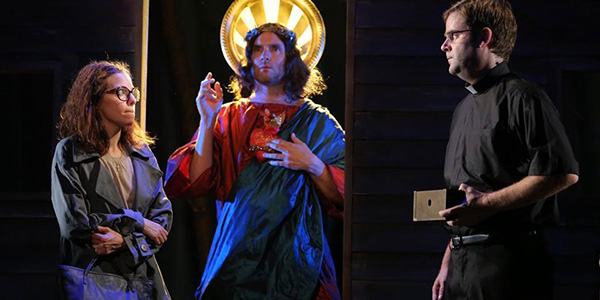
“The Patron Saint of Sea Monsters,” running through Dec. 1 at the Peter Jay Sharp Theater, is a divisive play. While some audience members may be convinced to leave during intermission, those who stay until the end will be treated to an outrageous show.
“Monsters” follows the baffling, backwater romance between Aubrey Lincoln (Laura Heisler), a sometimes charming, always quirky gynecologist, and Calvin Little (Rob Campbell), an oddball bad boy who appears to always be tipsy. Aubrey is fervently religious and frequently prays to St. Martyrbride, the patron saint of the spinster, sea monsters and those who suffer childhood infirmity. Aubrey is unmarried, has a nighttime back brace and has unequal leg lengths, which requires her to wear an orthopedic shoe.
Needless to say, Calvin and Aubrey’s love does not run a smooth course. Playwright Marlane Meyer casually throws the audience into the first scene with a casual opening scene in which Calvin weeps over the lifeless body of his first wife, Marie. Meanwhile, his howling, rowdy mother Helen orders his half-brother Jack to bury the corpse. The scene then cuts to an 18-year-old Aubrey fawning over a life-sized statue of Jesus Christ while her pill-popping socialite mother mocks her for wanting to marry the gaudy Messiah. The forceful Candy Buckley plays both mothers — she uses every part of her body and every tooth in her leer to create funny caricatures of these women.
While no one would call the performances of “Monsters” nuanced, the actors throw themselves into their roles. The two leads both make an admirable effort to bring credibility to their respective characters. Haynes Thigpen, Danny Wolohan and Jacqueline Wright all juggle multiple parts with remarkable versatility. Wolohan in particular is enviably at home on the stage.
Ultimately, the play, under its current direction by Lisa Peterson, is more about timing than sincerity. Everything from the all-or-nothing lighting to the loud costumes to the predictable set design strains for an immediate, superficial reaction from audience members rather than profound engagement. This partially results from the material itself. The play lacks one sane character or moment of simplicity to provide a much-needed mooring point — and sense of relatability — for the rest of the unhinged action.
As a result, Calvin’s ultimate reform at the hands of a good woman falls flat, culminating in an unsatisfying finale. It is, after all, difficult to reconcile complex character development with stagehands in animal masks, stuffed raccoons and a painted trailer for a backdrop.
A version of this article appeared in the Tuesday, Nov. 19 print edition. Clarissa Lehne is a contributing writer. Email her at [email protected].
























































































































































